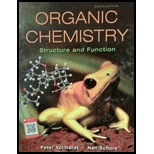
Concept explainers
(a)
Interpretation:The reaction schemes with proper usage of curved arrows in below reaction should be indicated and corrected for the cases that are inappropriate.

Concept introduction:The fundamental electrostatics suggests that electrons have more affinity for electron-deficient sites in an organic compound. or positive charge. The curved arrow is appropriate mechanism to depict electron movement that occurs from electron rich species to electron deficient species.
Bimolecular substitution or
A general

(b)
Interpretation: The reaction schemes with proper usage of curved arrowsin below reaction should be indicated and corrected for the cases that are inappropriate.

Concept introduction: The fundamental electrostatics suggests that electrons have more affinity for electron deficient sites in an organic compound. or positive charge. The curved arrow is appropriate mechanism to depict electron movement that occurs from electron rich species to electron deficient species.
Bimolecular substitution or
(b)
Interpretation: The reaction schemes with proper usage of curved arrows in below reactionshould be indicated and corrected for the cases that are inappropriate.

Concept introduction: The fundamental electrostatics suggests that electrons have more affinity for electron deficient sites in an organic compound. or positive charge. The curved arrow is appropriate mechanism to depict electron movement that occurs from electron rich species to electron deficient species.
Bimolecular substitution or
(d)
Interpretation: The reaction schemes with proper usage of curved arrows in below reactionshould be indicated and corrected for the cases that are inappropriate.

Concept introduction: The fundamental electrostatics suggests that electrons have more affinity for electron deficient sites in an organic compound. or positive charge. The curved arrow is appropriate mechanism to depict electron movement that occurs from electron rich species to electron deficient species.
Bimolecular substitution or
(e)
Interpretation: The reaction schemes with proper usage of curved arrows in below reactionshould be indicated and corrected for the cases that are inappropriate.

Concept introduction: The fundamental electrostatics suggests that electrons have more affinity for electron deficient sites in an organic compound or positive charge. The curved arrow is appropriate mechanism to depict electron movement that occurs from electron rich species to electron deficient species.
Bimolecular substitution or
(e)
Interpretation: The reaction schemes with proper usage of curved arrowsin below reaction should be indicated and corrected for the cases that are inappropriate.

Concept introduction: The fundamental electrostatics suggests that electrons have more affinity for electron deficient sites in an organic compound. or positive charge. The curved arrow is appropriate mechanism to depict electron movement that occurs from electron rich species to electron deficient species.
Bimolecular substitution or
Want to see the full answer?
Check out a sample textbook solution
Chapter 6 Solutions
EBK ORGANIC CHEMISTRY
- Calculate the pH and the pOH of each of the following solutions at 25 °C for which the substances ionize completely: (a) 0.000259 M HClO4arrow_forwardWhat is the pH of a 1.0 L buffer made with 0.300 mol of HF (Ka = 6.8 × 10⁻⁴) and 0.200 mol of NaF to which 0.160 mol of NaOH were added?arrow_forwardDetermine if the following salt is neutral, acidic or basic. If acidic or basic, write the appropriate equilibrium equation for the acid or base that exists when the salt is dissolved in aqueous solution. If neutral, simply write only NR. Be sure to include the proper phases for all species within the reaction. NaN₃arrow_forward
- A. Draw the structure of each of the following alcohols. Then draw and name the product you would expect to produce by the oxidation of each. a. 4-Methyl-2-heptanol b. 3,4-Dimethyl-1-pentanol c. 4-Ethyl-2-heptanol d. 5,7-Dichloro-3-heptanolarrow_forwardWhat is the pH of a 1.0 L buffer made with 0.300 mol of HF (Ka = 6.8 × 10⁻⁴) and 0.200 mol of NaF to which 0.160 mol of NaOH were added?arrow_forwardCan I please get help with this.arrow_forward
- Determine if the following salt is neutral, acidic or basic. If acidic or basic, write the appropriate equilibrium equation for the acid or base that exists when the salt is dissolved in aqueous solution. If neutral, simply write only NR. Be sure to include the proper phases for all species within the reaction. N₂H₅ClO₄arrow_forwardPlease help me with identifying these.arrow_forwardCan I please get help with this?arrow_forward
 Organic Chemistry: A Guided InquiryChemistryISBN:9780618974122Author:Andrei StraumanisPublisher:Cengage Learning
Organic Chemistry: A Guided InquiryChemistryISBN:9780618974122Author:Andrei StraumanisPublisher:Cengage Learning
